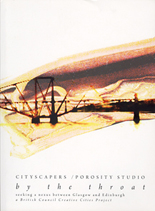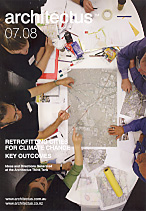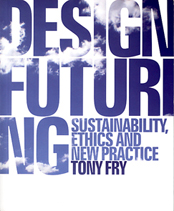URBANISTA
Design Labs for Urban Futures
By Linda Carroli
Arts Hub, March 2009
Design labs are providing Australian designers and artists with opportunities to collaboratively envision and conjure diverse urban futures. Such environments draw designers into a developmental environment to explore design as a means by which to address the challenges of urban living and life.
ONE
Under the umbrella of its Creative Cities program, Cityscapers is a British Council initiative that aims to support the development of emerging and young designers, architects and visual artists through collaborative work on design briefs in UK cities. This project is a partnership between the British Council, Professor Richard Goodwin’s Porosity Studio, University of New South Wales, and UK universities and institutions. In 2008, 60 young city-builders in the Asia Pacific and Europe examined the relationship between Edinburgh and Glasgow. The Australian contingent was 15. The lab culminated in an exhibition and publication with documentation also available at the British Council website. Participants focused on connection, identity and place by ‘re-programming’ what already exists and by developing strategies of transformation. This includes works, such as A Landscape Patina by Marina Breit and Sarah Foque, which disrupt the pattern of the cityscape as well as such design propositions as “What if a city is built on the concept of happiness?”.
Held from 27 March to 9 April, the 2009 Cityscapers involved over 70 artists, designers, architects, urban planners and filmmakers – with another 15 from Australia - who converged in Wales for Cardiff Chimera2020. Their aim was to investigate and respond to the relationships and future inhabitation of Cardiff, and its neighbourhoods, as a model for small waterfront cities in the year 2020. The studio looked at how to tackle issues of global warming, population growth, natural disaster and changing urban economies when designing neighbourhoods of the future and how these issues might specifically be addressed in the city of Cardiff in 2020 and beyond. A third and final Cityscapers will take place next year.
TWO
The architectural and urban design company Architectus coordinated and hosted a Think Tank on Retrofitting Cities for Climate Change in Sydney in April 2008. It's a shining example of industry and design response to climate and environmental change. Director of Architectus and Convenor of the Think Tank, Caroline Stalker, has produced a comprehensive publication. The Architectus Think Tank involved more than 40 prominent Australian urban designers, architects and planners working in an immersive and interdisciplinary solutions-finding environment for two days. In her introduction, Stalker said that “various scenarios were considered and solutions offered to deal with the implications of climate change in our cities”. Engagement of planning, design and engineering practitioners, while not the whole picture, is necessary to reducing the vulnerability of our cities.
Stalker observed that “despite the strategic importance of adapting our cities there is a notable absence of specific ideas about how planning and design should contribute. Indeed this was the primary context for the Retrofitting Cities for Climate Change think tank, as Architectus perceives an urgent need for revised design and planning policies. How will these changes impact society? What can the city-makers of this generation do to minimise the risks to the well-being of future generations?” The publication also documents the scenarios that were workshopped in small groups. These scenarios were actual development projects/sites located in different contexts from urban fringe to coastal edge, each presenting a diverse range of innovative approaches to defence, density, connection, greening, retrofit and energy.
THREE
Closer to home, I've participated in three weekend design futures workshops and presentations over the past year. The workshops spring out of the Design Futures program at Griffith University (Queensland College of Art). Led by Tony Fry, who convenes that program, the workshops have provided opportunities for participants to engage with, and develop an approach to, ‘redirective practice’. His ideas are detailed in his recently launched book, Design Futuring: Sustainability, Ethics and the New Practice (UNSW Press, 2009), in which the importance of redirective practice is described as “elevat[ing] the seriousness, importance and futuring potential of design”. This involves taking design beyond a disciplinary model so that a transformation of knowledge is enabled. Fry describes this as ‘redesigning design’. Given that humanity – its cities and institutions – continue to create problems rather than implement solutions, redirection has become an imperative.
Fry paints a grim picture of the present – a present from which no viable human future is possible without deep transformation. He proposes that current regimes of production and consumption coupled with piecemeal environmental sustainability measures merely ‘sustain the unsustainable’. He situates design as integral to the development of ecological sustainment. “The future will not happen by accident,” he says. “It can only happen by design.” This requires redirection. Within Fry’s propositions lies an urgent critique of current designing thinking and theory.
In Fry’s presentation of environmentally related problems, he weaves a poetic language of wordplay, where meaning is multiplied and stretched. Expressions like “a possibility of a future with a future” pepper his speech and writing. Despite the difficulty of the subject - in that no one really likes to hear of the enormity of environmental degradation that will ultimately see the demise of humanity - Fry’s even speech and demanding ideas make him compelling. He is a pleasure to listen to and a pleasure to read. In the first workshop I attended, one of the participants sat rocking in her chair as she listened – not as if lulled into a trance, but as if she found, in language and listening, a vital rhythm.
The workshops involved university staff, students from the postgraduate program and others. Those who participated in all three workshops included Petra Perolini, a designer and academic at QCA, Will Odom, an American interaction design researcher in Australia on a Fulbright Scholarship, Nora Kinnunen of the family-run and award winning Deka Furniture, and me with an interdisciplinary writing and consulting background. Other participants were drawn from interior design, architecture, academia and various design practices. Each workshop was the launch pad for a public seminar intended to draw others into a public conversation about design and redirective practice.
The second workshop, held in 2008, had a collaborative lab approach in which participants explored possible environmental and design futures for Brisbane in 2048. The impetus in these investigations was neither reform nor revolution, but a strategic effort to redesign design. In considering the impacts and causes of climate change – ranging from heat islands to environmental refugees to peak oil to dwindling agricultural land - the group developed a program of design responses to the city and a program of design for the city. These included consideration of decentring the city, retrofitting, green screening, infill development, citizen science/design resources, revised building codes and localised renewable energy capture.
The condition we live in as a result of humanity’s unrelenting consumption of resources is ‘defuturing’ (the future is diminished) and Fry stresses the need for designers to ‘design things away’. The most recent design futures event, held last month, explored and presented an argument for a ‘qualitative economy’ to displace the current system of capital logic driven by ever-growing production and consumption. In speaking for a reinvigorated economy of symbolic exchange, Kinnunen said, reading a collaboratively written statement, “what is at stake is what makes life meaningful, cared for and conserved”. With the dark cloud of recession hovering above us, the speakers observe that the state’s response has been to stimulate consumption: “the solution is the continuation of the problem”. At the first seminar in 2008, University of Western Sydney Lecturer Tara Andrews addressed the emergence of industrial design as a strategy to stimulate consumption and demand during the 1930s depression. Since then, consumerism has exploded with university design programs complicit in fuelling this continuing and unsustainable growth and avaricious consumption of resources.
The propositions in response to the current economic system are diverse and include the creation of a new qualitative economy. This may mean the restoration of craft, quality and care – the result of which is to consume better, less frequently or to design things away. One audience member made the challenge explicit in asking “How are you going to convince all those readers of Vogue to buy only one pair of shoes every 20 years?” Others challenged the group to put some ‘answers’ on the table. Case studies of redirected practice are presented in Design Futuring: Sustainability, Ethics and the New Practice such as Team D/E/S’s award winning Boonah Two project which was a redirective practice response to a competition brief of designing a sustainable city. The workshop participants – disparagingly referred to as the ‘collective’ at one point when challenged to produce solutions – have not sought to position themselves as a self-privileging think tank or thought leader (there are far too many of those around), but rather has participated in and initiated another kind of conversation. For sure, these seminars and workshops have dwelled in the space of ‘the problem’ sometimes developing abstract and seeming impossible responses. I feel bruised by this problem, and perhaps that is rightful because the problem is indeed hurting us. Having scoped the problem, Fry asserts, the purpose of the workshops and seminars has been to redirect design thinking, practice and practitioners. Even so, there remains a need to be attentive to the spaces of discomfort as a participant– the lauding of traditional and Indigenous knowledge but the absence of Indigenous voices and acknowledgement in discussion, and the desire for an inclusive conversation but the spiralling of a terse right/wrong jostle between various truths. Change and newness is fraught and fractious. Conversations might need design too.
Each of these events pursues markedly differently design research and practice trajectories, shaping a kind of interzone: a space that is and is not. Within them, the fields of design thinking/thinking design are plastic and plural. Groups are professionals and practitioners are able to mount pressure for change. All these labs share a commitment to interdisciplinary collaboration, perhaps riding transformative post-disciplinary currents. There’s something inherently relational about these ventures with the potential for more reflexive exchanges across practice, interdisciplinarity, change and research. In terms of redirective practice, it means ‘retrofitting professional knowledge’. Participants are able to renegotiate practice and practice a type of collaboration that is (re)directed as a suitable design response to the challenges of urbanism and climate change.
Postscript:
Coming up in July, Urban Islands is a 12-day intensive masterclass taught by three groups of international emerging architects on and about Cockatoo Island in Sydney Harbour. With enrolments currently open, the masterclass is open to architecture students across Australia, interleaving lectures and collaboration with local urban authorities and questioning “the creative-socio-spectacle of the event on this urban blindspot”. The Urban Islands Project aims to establish an innovative framework to encourage dialogue, experimentation and participation in the reprogramming of valuable post-industrial sites within the city.